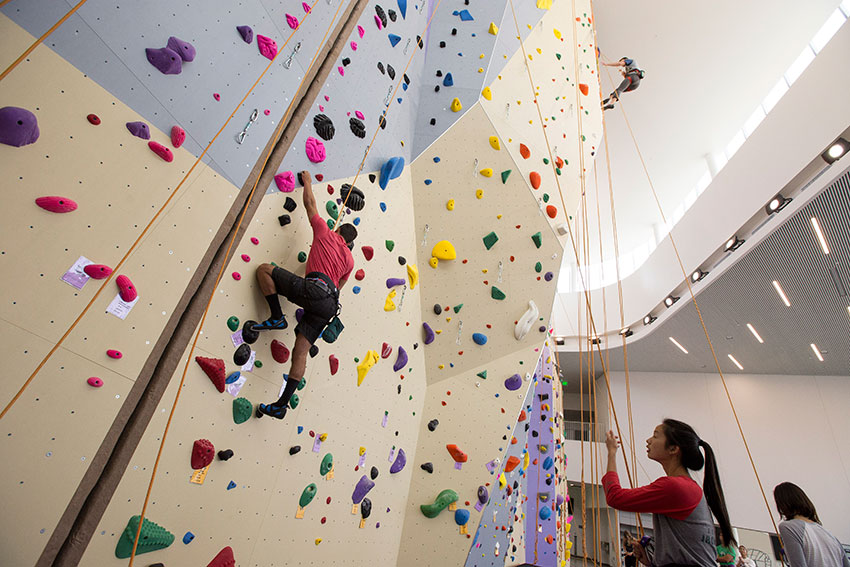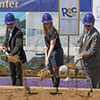Green-designed Mashouf Wellness Center opens its doors

Students exercise on the climbing wall at the Mashouf Wellness Center, which opened its doors on Wednesday, Aug. 23.
After 2 years of construction, environmentally friendly facility now a hub of student activity
Student life on San Francisco State University’s campus has changed in a major way.
From sunrise until well into the evening, students are scampering up a two-story climbing wall, playing indoor soccer or swimming in one of two pools at the Mashouf Wellness Center — all within easy walking distance of student housing and the center of campus.
The striking new building at the corner of Lake Merced and Font boulevards, which has been under construction since the summer of 2015, is now a regular destination for students and the SF State community to meet for fun and exercise. It was the first major on-campus construction since The Village at Centennial Square student housing complex was completed in 2001.
The center opened its doors on Wednesday, Aug. 23. A grand opening and ribbon-cutting ceremony is scheduled for 12:30 p.m. on Tuesday, Aug. 29. President Les Wong, alumnus Manny Mashouf and Campus Recreation Director Pamela Su will speak at the event.
“The center has made our University more beautiful and will bring our campus community closer together,” Wong said. “I know it will act as a social catalyst and will give students another reason to stay on campus after their classes are done for the day.”
The 118,700-square-foot facility features fitness and weight areas, courts for racquetball and squash, two wood-floored studios, one matted exercise studio, a sauna, a lap pool, a recreation pool and a large multi-use space that can host team sport activities, as well as student events like dances and large lectures.
A purple indoor jogging track wends its way past dozens of treadmills, stationary cycles and Stairmasters on the second floor, then cruises past the indoor soccer area and the multi-sport gym. Natural lighting from two-story windows helps guide the way and give runners a view of Lake Merced Boulevard, the neighboring softball field and Font Boulevard. It takes six laps to make a mile, Su said.
The $86.5 million center was funded by student fees and private donations, including a lead gift from Mashouf, founder of the women's fashion brand bebe.
“I’m proud that this boldly designed facility will be a major part of student life for decades to come,” Mashouf said.
The center will be open from 6 a.m. to midnight from Monday through Thursday and 6 a.m. to 11 p.m. on Fridays. On Saturdays, it will be open 11 a.m. to 9 p.m. and on Sundays, 11 a.m. to 11 p.m. For students, the $160 per semester recreation center fee is included in the student fee. Faculty and staff can purchase annual or semester-long memberships. Alumni who are interested in using the center can contact membership coordinator Marcus Ramirez at mramirez31@sfsu.edu.
Current recreation facilities are housed in the 1950s-era Gymnasium building and shared with the University’s athletic teams and the Department of Kinesiology. That has limited the amount of space and equipment available to students, Su said.
“We want this to be a hub of the campus community, not only for those who want to maintain their health and relieve stress, but also for students who want to socialize, meet others and create friendships,” she said.
The center was designed with the latest advances in green building technology in mind. It’s on track to be rated LEED (Leadership in Energy & Environmental Design) Platinum, the highest designation for green construction.
Construction plans incorporated cutting-edge technologies to significantly reduce energy and water usage. Pool discharge water is captured and filtered for reuse in toilet flushing, for example, and a greywater system repurposes shower and sink wastewater to irrigate the site. Other environmentally friendly features include LED lighting, drought-resistant landscaping and a displacement ventilation system to minimize the use of air conditioning.
The University's most recent major construction project was the renovation of the J. Paul Leonard Library, which received an addition of more than 70,000 square feet in 2012.
